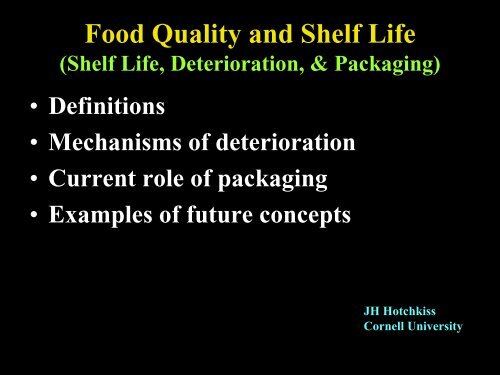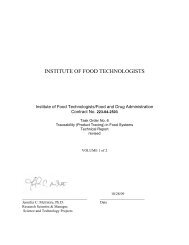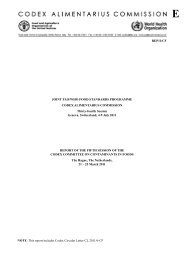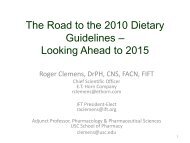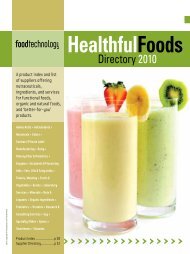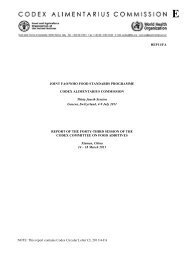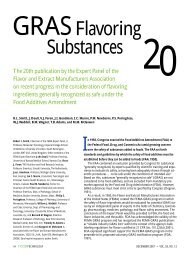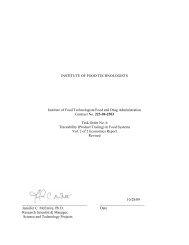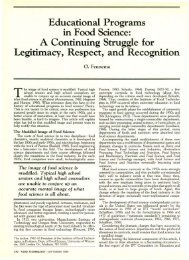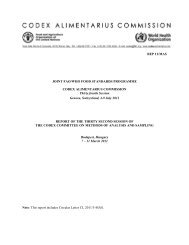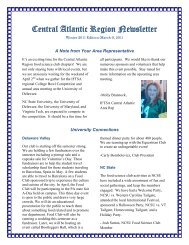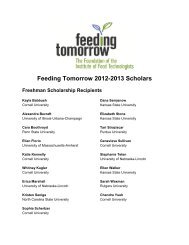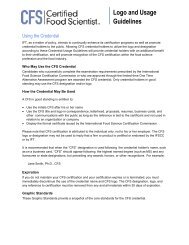Food Quality and Shelf Life
Food Quality and Shelf Life
Food Quality and Shelf Life
Create successful ePaper yourself
Turn your PDF publications into a flip-book with our unique Google optimized e-Paper software.
<strong>Food</strong> <strong>Quality</strong> <strong>and</strong> <strong>Shelf</strong> <strong>Life</strong><br />
(<strong>Shelf</strong> <strong>Life</strong>, Deterioration, & Packaging)<br />
• Definitions<br />
• Mechanisms of deterioration<br />
• Current role of packaging<br />
• Examples of future concepts<br />
JH Hotchkiss<br />
Cornell University
Objective<br />
• Describe the problems <strong>and</strong> needs related to<br />
food quality <strong>and</strong> shelf life.
<strong>Food</strong> <strong>Quality</strong><br />
• Degree to which a food meets expectations<br />
• “High” exceeds expectations<br />
• “Low” does not meet expectations
Expectations for <strong>Food</strong><br />
• “Taste” (appropriate sensory factors)<br />
– Appearance, texture, taste, odor, auditory<br />
• Nutrition/Healthful profile<br />
• Convenience & preparation<br />
• Storage shelf life<br />
• Intangible needs & benefits<br />
• Physical structure<br />
• Safety & environmental costs
What is the <strong>Shelf</strong> <strong>Life</strong> of Milk?<br />
• Stored at room temperature.<br />
• Aseptically processed <strong>and</strong> packaged.<br />
• The shelf life of a food depends on<br />
– How it is processed<br />
– How it is stored<br />
– How it is packaged
<strong>Shelf</strong> <strong>Life</strong><br />
• The time it takes a food product to<br />
deteriorate to an unacceptable degree under<br />
specific storage, processing, <strong>and</strong> packaging<br />
conditions.
Time to Deteriorate is Relative<br />
• Product composition<br />
• Storage conditions<br />
– temperature<br />
– atmosphere<br />
• Processing conditions<br />
• Distribution conditions<br />
• Initial quality<br />
• Packaging
<strong>Shelf</strong> <strong>Life</strong> Plots<br />
<strong>Quality</strong> Parameter(s)<br />
Conventional<br />
Package<br />
ESL Provides higher quality<br />
at any time<br />
ESL Package<br />
MAQ<br />
SL1<br />
Time (hrs, days, wks, months)<br />
SL2
Selected Measurable <strong>Food</strong><br />
<strong>Quality</strong> Factors<br />
• Microbial counts <strong>and</strong> types<br />
• Nutrient content<br />
• Color & appearance<br />
• Moisture content<br />
• Physical shape/size<br />
• Mechanical properties<br />
• Flavor panel score<br />
• Toxicant level (chemical risk)<br />
• DAL (e.g. insect fragments)
Setting Minimum<br />
Acceptable <strong>Quality</strong><br />
• Regulatory limits (e.g. 20,000 cfu/ml)<br />
• Just noticeable difference (JND)<br />
– Sensory<br />
– Expert vs. consumer<br />
• Customer complaints<br />
• Detected by >50th percentile of<br />
consumers<br />
• MAQ IS A MANAGEMENT DECSION
Modes of <strong>Food</strong> Deterioration<br />
• Biological<br />
– Microorganisms<br />
• spoilage<br />
• pathogenic<br />
– Vermin<br />
• insects<br />
• rodents
Modes of <strong>Food</strong> Deterioration<br />
• Chemical<br />
– Oxidation<br />
– Flavor deterioration<br />
– Color change or loss<br />
– Vitamin loss<br />
– Chemical contamination<br />
– Enzymatic
Modes of <strong>Food</strong> Deterioration<br />
• Physical<br />
– Moisture gain or loss<br />
– Breakage or clumping<br />
– Textural changes<br />
– Contamination (objects)
Motivations for<br />
Extending <strong>Shelf</strong> <strong>Life</strong><br />
• Reduce distribution costs<br />
• Enter new markets<br />
• Non-traditional distribution channels<br />
• Improve quality<br />
• Reduce restocking costs<br />
• Provide longer code dates
Peroxide Value<br />
Peanut Snack <strong>Shelf</strong> <strong>Life</strong><br />
Packed in air<br />
Packed in 80% N 2<br />
Packed in 95% N 2<br />
Pox=3<br />
0 10 20<br />
Time (wks)
Major Goal of Packaging<br />
• Reduce the rate of quality loss<br />
• Increase the shelf life of the product
Recent Packaging Technologies<br />
to Extend <strong>Shelf</strong> <strong>Life</strong><br />
• Higher barrier packaging<br />
• Modified atmosphere packaging (MAP)<br />
• Direct addition of CO 2 to products<br />
• Broader use of irradiation<br />
• New processes (e.g. high pressure, ohmic,<br />
pulsed light, etc.)
Question: In what ways could<br />
packaging improve food quality<br />
<strong>and</strong> shelf life beyond current<br />
technologies?<br />
What new packaging materials or methods could be<br />
developed which would improve quality <strong>and</strong> shelf life?<br />
What research is needed to affect these improvements?
Examples of Emerging Packaging<br />
Technologies Which May<br />
Extend <strong>Shelf</strong> <strong>Life</strong><br />
• Antimicrobial Materials<br />
• Bio-Active Materials<br />
• Selective & Adjusting Barriers<br />
• Indicating & Sensing Materials<br />
• Flavor Maintenance & Enhancing Materials
Example:<br />
Antimicrobial Packaging
Scanell et al 2000<br />
Nisin Impregnated Antimicrobial<br />
Film/Paper
Antimicrobial Peptides
Immobilization on PS Beads<br />
Polymer<br />
Bead<br />
Peptide<br />
Spacer<br />
Molecule
Concentration (mg/ml) of SMPS required to give a 3 log<br />
reduction in counts in buffer in 10, 30, or 60 min at 25°C<br />
• ORGANISM 10 MIN 30 MIN 60 MIN.<br />
• E. coli 0157:H7 8 5 4<br />
• S. typhimurium 18 17 8<br />
• S. liquefasciens 8 5 ND<br />
• P. fluorescens 7 5 3<br />
• B. subtltis 3 3 2<br />
• L.monocytogenes 12 5 3<br />
• S. aureus >60 57 50<br />
• K. marxiamus 16 9 8
Example: Selective/Adjusting<br />
Barrier Films
CO2 production<br />
(mg kg -1 h -1 )<br />
CO 2 production<br />
12<br />
10<br />
8<br />
6<br />
4<br />
2<br />
0<br />
0<br />
0<br />
b<br />
ab<br />
ad<br />
bd<br />
7.5<br />
7.5<br />
CO 2 (kPa)<br />
ab<br />
15<br />
15<br />
CO 2 (kPa)<br />
b bc<br />
c<br />
30<br />
30<br />
b<br />
a<br />
0<br />
0<br />
1<br />
0.5<br />
0.5<br />
1.0<br />
O 2 (kPa)<br />
O 2 (kPa)<br />
Effect of Atmosphere on Cut Apple Respiration<br />
Gurbuz & Hotchkiss, 2001
Optimizing Film Permeation for<br />
Cut Fruits <strong>and</strong> Vegetables<br />
• Senescence <strong>and</strong> decay are closely related to<br />
– temperature<br />
– ethylene exposure<br />
– composition of the surrounding atmosphere<br />
• Atmosphere composition relates to<br />
– respiration rate<br />
– package permeability & Permselectivity<br />
– film permeability & area/product mass ratio
Permselectivity<br />
Permselectivity (β) = ratio of CO 2<br />
permeability coefficient (P CO2 ) to O 2<br />
permeability coefficient (P O2 ), β =P CO2 /P O2
Perm Selectivity & Cut Apples<br />
Under optimum atmosphere of 30% CO 2 , 0.5% O 2 ;<br />
R CO2 = 2.1 Kg/hr, <strong>and</strong> RQ = 1.9 (Gunez & Hotchkiss, 2001).<br />
Assume: Package A= 1320 cm 2 ; x= 1 mil; mass apples = 2.27 Kg;<br />
bulk apple volume = 3818 cm 3 ; package volume = 5090 cm 3 ; <strong>and</strong><br />
headspace = 1272 cm 3 ; optimum CO 2 ; y oCO2 = 0.30; O 2 ; y oO2 = 0.005;<br />
external CO 2 <strong>and</strong> O 2 concentrations; y eCO2 = 0; <strong>and</strong> y eO2 = 0.21.<br />
Calculated (Exama et al, 1993) required permeability for fresh-cut<br />
apples is:<br />
P R CO2= WR CO2 L/Ap(yoCO 2 -yeCO 2 ) = 1.2 x 10 -2 mL mil/cm 2 hr atm<br />
P R O2= WR O2 L/Ap(yeO 2 -yoO 2 ) = 9.23 x 10 -3 mL mil/cm 2 hr atm<br />
P R CO2/ P R O2 = 1.3
Permselectivities of Some<br />
Common Films<br />
Material Perm Coeff. Permselectivity<br />
CO 2 O 2 CO 2 /O 2<br />
LDPE 99 27 3.7<br />
PP 58 9 6.2<br />
PVC 0.65 0.19 3.4<br />
Cell. Acetate 348 10 34<br />
PET 53 6.1 8.7<br />
Ionomer<br />
__<br />
-- 4.2<br />
Nylon 6 1.6 0.38 4.2<br />
Al-Ati & Hotchkiss, 2001
Recommended Gas Composition for Fruits <strong>and</strong><br />
Permselectivity of Plastic Films<br />
21<br />
18<br />
Blackberry, Blueberry, Fig,<br />
Raspberry, Strawberry<br />
A= LDPE (6.7)<br />
CO2 Concetration (%)<br />
15<br />
12<br />
9<br />
6<br />
F E<br />
A<br />
3<br />
C<br />
B<br />
D<br />
B= HDPE (4.8)<br />
Cherry<br />
C= PET (3.4)<br />
D= Saran (10)<br />
Avocado<br />
Grapefruit<br />
E= PVC (6)<br />
F= PA (5)<br />
Orange<br />
0<br />
0 3 6 9 12 15 18 21<br />
O 2 Concetration (%)<br />
Al-Ati & Hotchkiss, 2001
Example: Microbial Condition
ANTIBODY GRID<br />
LASER<br />
DIFFRACTION<br />
PATTERN<br />
bacteria
Conclusions<br />
• Packaging plays a central role in reducing<br />
the rate of quality loss in foods.<br />
• There is a need for technologies that reduce<br />
the rate of food deterioration <strong>and</strong>/or<br />
provide information about the quality/safety<br />
of foods.<br />
• Research & development will be necessary<br />
to affect these desirable changes.


